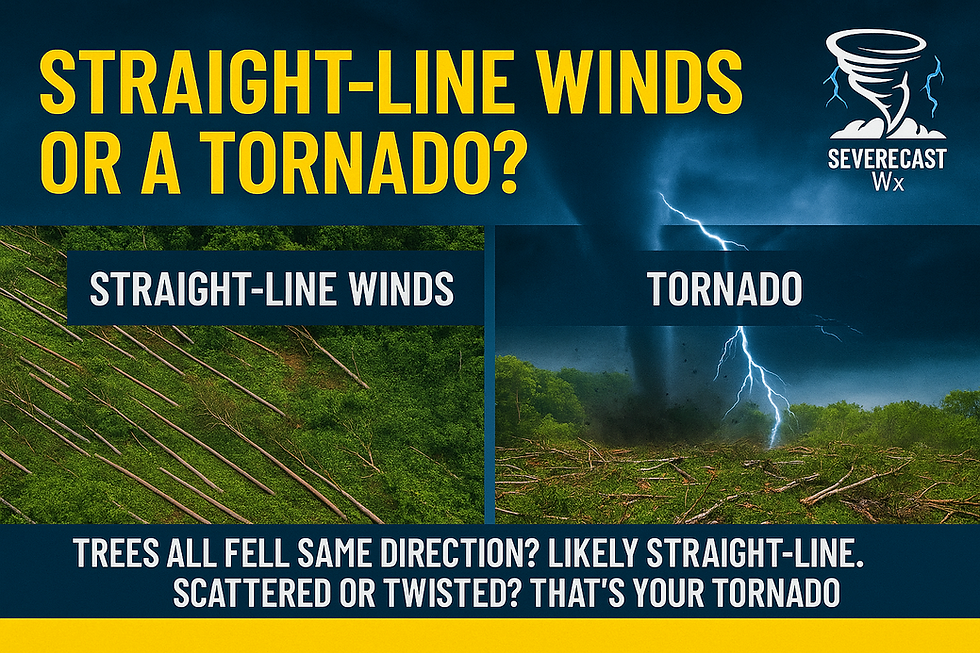Heatbursts: The Midnight Furnace of the Atmosphere
- Nicole Carbone
- May 25
- 4 min read
When you think about heat, you probably picture sweltering afternoon sun or the stifling warmth of a summer evening. But what if we told you that temperatures can spike 20-30 degrees after midnight, with winds howling and humidity crashing to single digits, all without a single ray of sunlight?

Welcome to the bizarre world of heatbursts, one of the rarest and least understood weather phenomena that can turn a calm night into a furnace blast. Let's dive into that they are, how they happen, and why they can be surprisingly dangerous.
What Exactly Is a Heatburst?
A heatburst is a sudden, localized event characterized by:
Rapid temperature increase
Sharp drop in humidity
Strong, gusty winds
Usually happening at night, after storms are dying out.
These events are not your typical warm breeze, they can cause late-night temperatures to spike from the 70s into the 100s in under 30 minutes, all while ripping through with winds over 60 MPH. Unlike normal heating, which comes from the sun, heatbursts are powered by descending air from collapsing thunderstorms.
The Science Behind Heatbursts
To understand heatbursts, you have to think in reverse compared to how storms usually form. Here's how it works, step by step:
A Thunderstorm Begins to Die
- As a thunderstorm loses its fuel (instability, lift, and moisture), its powerful updrafts collapse. The storm begins to decay.
Rain Falls Into a Dry Layer
- Some of the leftover rain from the storm starts to fall into a layer of dry air beneath the storm cloud. But instead of reaching the ground, the rain evaporates before it hits, a process called virga.
Evaporation Cools the Air (Briefly)
- This evaporating rain cools the surrounding air, making it denser. Denser air begins to sink rapidly, this is where things get interesting.
Sinking Air Compresses and Heats
- As this now-cold, dry air plummets toward the surface, it compresses due to higher atmospheric pressure near the ground. And just like air being compressed in a bike pump, it heats up, fast. By the time it slams into the surface, this air is no longer cold, its been superheated and dried out. The result? A blast of hot, dry wind, often with little to no warning.
What Does a Heatburst Feel Like?
Imagine it's 1:00 AM and you've got the windows open, enjoying a peaceful 72 degree night.
Then suddenly, the temperature jumps to 98 degrees in 10 minutes, the wind roars through like a freight train and the air turns dry as a desert.
That's a heatburst. You might not even know a thunderstorm was nearby, often, the storm has already fizzled out or passed to another region. It's a ghostly aftermath of the atmosphere's earlier chaos.
Are Heatbursts Dangerous??
Yes, they can be deceptively dangerous, despite being rare.
Here's why:
Damaging Winds
- Winds associated with heatbursts can reach 50-70 MPH, strong enough to knock down tree limbs, damage roofs, disrupt outdoor events, topple unsecured structures.
Fire Risk
- The hot, dry air from a heatburst causes relative humidity to plummet, sometimes into the single digits. This creates ideal conditions for wildfire ignition, especially in drought-prone areas.
Health Concerns
- For those without air conditioning or with underlying conditions, a sudden spike in overnight heat can trigger heat exhaustion or heat stroke, aggravate respiratory problems.
Agricultural Damage
- For farmers, heatbursts can scorch crops, especially delicate plants that aren't equipped to handle abrupt, extreme heat combined with dry wind.
When and Where Do They Happen?
Heatbursts are most common in the Central and Southern Plains of the U.S., particularly:
Oklahoma
Kansas
Texas
Occasionally in parts of the Midwest and Southeast
They tend to occur in late spring through summer, typically after midnight, when thunderstorms begin to decay in a stable, dry atmosphere. However, heatbursts can technically happen anywhere in the world, anywhere a collapsing storm meets dry mid-level air.
Notable Heatburst Events
June 6, 1994 - Copan, Oklahoma
A legendary heatburst raised temps from 85 degrees to 101 degrees after midnight, accompanied by 70+ mph wind gusts. Residents reported feeling like they'd opened an oven door.
May 22, 2011 - Wichita, Kansas
During the night, temperatures spiked from 85 degrees to 102 degrees around 12:22 AM. Winds howled over 60 MPH. Emergency services were inundated with calls about fires and wind damage.
July 1960 - Abilene, Texas
One of the earliest documented heatbursts, temperatures rose from 70 degrees to 96 degrees just after 1:00 AM.
Can Heatbursts Be Predicted?
They are very difficult to forecast. Most of the time, meteorologists won't know one is happening until:
A weather station records a sudden spike in temperature and wind
A report comes in from residents
However, there are a few key ingredients that can raise flags:
A decaying thunderstorm overhead or nearby
Dry air below mid-levels of the atmosphere
Calm overnight conditions before a sudden wind surge
Even then, the exact timing and location is nearly impossible to predict. That's why public awareness is so important.
Heatbursts may be rare, but they serve as a reminder of how dynamic and unpredictable the atmosphere can be, especially after storms. They don't make the headlines like tornadoes or derechos, but they can cause real damage and put people at risk, especially if caught off guard.
So, the next time your weather station reads 99 degrees at 1:30 AM and your windows are rattling in the wind... you just might be witnessing a heatburst.
As always, stay weather-aware, even after the storm passes.





Comments